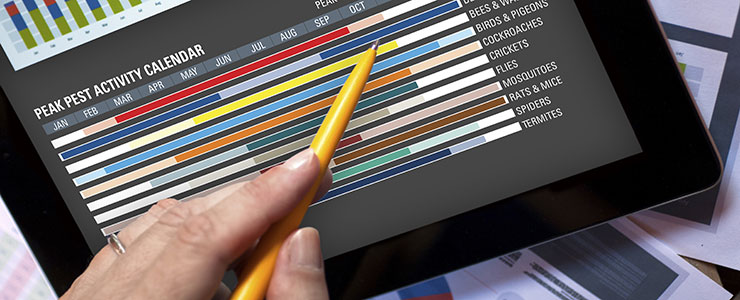
By understanding insect behaviors, Truly Nolen pest professionals can proactively introduce control measures in order to implement a very effective pest management program. Our technicians do the right things at the right time!
Truly Nolen’s Research and Development team created a proactive Insect Control Program addressing the changes in pest behavior from season to season. Instead of using the same material over and over again, the Truly Nolen program uses a series of high quality and environmentally conscious materials, which minimizes insect resistance over time.

Spring is the time when insects strive to increase their populations so Truly Nolen is focused on material application that reduces reproduction. The treatment focuses on the exterior of the structure where insects live and breed, plus entry points into the living space. The technician takes a proactive posture against insect invasion by using a material that works to eliminate the colony and establishes long-term protection to stop the insect invasion.
Remove spider webs
Apply dust treatment to exterior entry points including utility boxes and attic access points
Treat exterior hot spots, potential harborage sites and food sources
Power treat along foundation and in landscape features
Place granular bait for ant larvae and workers, crickets, and roaches
Apply granular ant bait to suppressant reproduction

Increased insect populations eat voraciously during the summer. Why do we see more of them in the summer? Because insects can move faster during the summer, they are less afraid of predators which are more likely to be seen. It’s the right time to treat the landscape and harborage areas where insects live. Truly Nolen meets “speed with speed” by using fast-acting products during the summer.
Remove spider webs and apply repellent
Treat exterior entry points and hot spots
Power treat along paved surfaces and landscape features including walkways
Spread granules in thick grass, mulch, rock beds, decorative bark and similar areas
Apply granular baits to minimize insect reproduction

Young insects are maturing and all pests are building up their reserves for the winter and are actively seeking harborage. Because they are slowing down, insects are more vulnerable to predation. Your home is a desirable insect retreat. To repel them, the technician establishes a barrier around the home by applying materials in pathways that insects will use to access the structure and caulking small insect entry points such as those found around window frames and utility entry points.
Remove spider webs
Apply dust treatment to exterior entry points including utility boxes and attic access points
Treat exterior hot spots, potential harborage sites and food sources
Caulk cracks and crevices where insects may gain entry in winter
Spread granules in thick grass, mulch, rock beds, decorative bark and similar areas
Place rodent monitoring stations (as needed)

During the winter, insects hide and reserve energy so that they can increase their chances of surviving until Spring. Because your home is an ideal insect retreat, the technician’s focus is on eradicating insects that are taking refuge inside the home. Truly Nolen establishes a long-term approach by using naturally occurring products to protect the interior of the home against insect invasion throughout the year.
Wipe webs inside
Apply material inside cracks and crevices, including baseboards and wall plates
Perform dust treatment in attic and crawl spaces
Place ant and roach bait stations under kitchen and bathroom sinks
Place insect monitoring stations in critical areas
Apply material outside around doors, windows and eaves